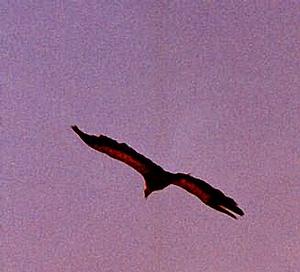 |
1st
Sept. At
Malame.
100 plus purple herons.
|
 |
2nd
Aug. At Galatas.
On the National road, a dead barn owl.
At Sirili. We saw 2 honey buzzards.
|
 |
4th
Sept. At Neo Chorio.
A
short toed eagle - the right hand mans favourite bird.
At Tavronitis.
There were flocks of gargeney, 30 plus another 20; and 13 sandwich terns.
|
 |
6th
Sept. At Neo Chorio. A flock of bee eaters passed by.
|
 |
7th
Sept. At Gerani. Were 12 plus bee eaters.
|
 |
8th
Sept. At Neo Chorio.
A
single kestrel.
|
 |
9th
Sept. At Neo Chorio.
We saw a
short toed eagle.
|
 |
10th
Sept. At Tavronitis. A
little egret, while:-
At Sirili.
There was a booted eagle.
|
 |
13th
Sept. At Neo Chorio.
Bee eaters heard
passing overhead, plus gun shots, presumably from locals hunters.
At Maleme. 2 purple heron.
|
 |
14th
Sept. At Neo Chorio. There was a Robin singing.
|
 |
18th
Sept. At
Neradzia.
More bee eaters.
If only they would learn to be quiet they
would have a better survival rate.
At Sirili.
2 honey buzzards.
At Tavronitis. A
kingfisher.
|
 |
19th
Sept. At Tavronitis.
There was a
lesser spotted eagle;
1 adult and 1 juvenile purple heron; a sakar; a white wagtail; a female hen harrier; plus more bee eaters.
|
 |
20th
Sept. At
Galatas.
A turtle dove, whilst:-
At Tavronitis.
Were purple heron; sandwich terns; wood
sandpipers; and a light phase eleonoras falcon.
Editors Note: An eleonoras falcon at Tavronitis
was the last recorded bird-sighting in Paul
Smiths diary. Paul died from cancer on October 2nd at Chania General
Hospital - where he had been admitted just hours previously - and but a few
days after his last sighting was recorded. His loss to the bird-watching
community is great, his contribution of enormous importance. We will
ensure that his diary recordings here at CretanVista continue to be
available. **Copyright is now the property of his widow Sandra, and all
rights are asserted. Her permission is required for any reproduction
in any form. It can be sought via our contact address which will be found
on the home page. A link to that page is below.
|

